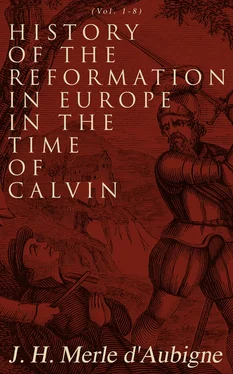CHAPTER XII.
BLANCHET AND NAVIS EXECUTED. THEIR LIMBS SUSPENDED TO THE WALNUT-TREE NEAR THE BRIDGE OF ARVE.
(October 1518.)
Table of Contents
The bastard was staggered when he was informed that Bonivard had escaped. He consoled himself, however, with the thought that he had at hand the means of gratifying his tastes and his revenge, and concentrated all his attention on Navis and Blanchet. What should he do with these two young men who had so thoughtlessly fallen into his net? How, in striking them, could he best strike the independent men of Geneva? For he was not thinking merely of getting rid of these two adventurers, but of filling all the city with terror by means of their death. To no purpose was he reminded that the father of one of the prisoners was the most zealous of his officers; the bastard cared little for a father’s grief, and thought that Peter Navis would serve him still better, when he had given him a striking example of the manner in which he desired to be served. He pressed the court to hasten on the trial. Ancina, judge in criminal matters; Caracci, seignior of Farges, and attorney-general of Savoy; and Licia, his deputy, constituted by ducal letters judges of Navis and Blanchet, declared them solemnly convicted, first, of having been present at the meeting at the Molard, and of having promised, they and their accomplices, to be ‘unanimous against the bishop’s officers, to rescue out of their hands any of their number whom these episcopal agents might take into custody; second, of having proposed, in case the duke should take part against them, to flee and place themselves under a foreign government (Switzerland), abandoning thus the sovereignty of Savoy and the splendour of the white cross.’ The two prisoners were condemned to be beheaded, and then quartered, according to the bishop’s desire. They prepared for execution immediately. 166
Navis breathed not a murmur; the feeling of his disobedience to his father closed his lips; it appears also that Blanchet recovered from his terror, dried his tears, and acknowledged his folly. Nothing indicates that the repentance of these two Genevan youths was truly christian; but it would be unjust to overlook their noble confession at the hour of death. The provost and his men, having received them from the hands of the magistrates, led them to the place of execution. Their appearance was becoming, and their look serious; they walked between their guards, calm, but without weakness or alarm. When they had mounted the scaffold, Navis spoke: ‘Wishing before all things to make amends for the evil we have done, we retract all that we have said touching certain of our countrymen, and declare that such avowals were extorted from us by the fear of torture. After proclaiming the innocence of others, we acknowledge ourselves guilty. Yes, we have lived in such a way that we justly deserve death, and we pray God, in this our last hour, to pardon our sins. Yet understand, that these sins are not those of which we are accused; we have done nothing contrary to the franchises and laws of Geneva: of that we are clean.... The sins which condemn us are our debaucheries.’ Navis would have continued, but the provost, vexed at what he had said already, ordered the executioner to do his duty. The man set to work instantly: the two young men knelt down, he raised his sword, and ‘thus they were beheaded, and then quartered.’ 167
At last the bishop saw his desires satisfied; he had in his possession the heads and the quarters of two of the ‘children of Geneva.’ This little man, so frail, livid, hideous, reduced almost to a shadow, without genius and without will, had nevertheless the will and the genius of evil. Notwithstanding his protest against the mutilation of limbs , he decided that three of the quarters of the two bodies should be exposed over the gates of Turin, and reserved for his own share a quarter of Navis and of Blanchet, with the two heads. He had the flesh pickled, for he intended to keep them as long as possible; and when this savage operation, worthy of the Mohawks, was completed, he placed the heads and limbs in two barrels on which were marked the arms of the count, the duke’s brother. The bishop wished to show his flock a sample of his cleverness; and as the execution did not take place at Geneva, he intended at least to send the limbs of the victims ‘to stir up and terrify the scoundrels.’ The bearers of these two pickle-tubs started from Turin, crossed Mont Cenis, arrived in the basin of the Leman on Saturday, October 2, 1518, and lodged on ‘the other side of the Arve.’ 168
On the bank of this river, which then separated the ducal states from those of Geneva, at the foot of the bridge on the Savoy side, stood a fine walnut-tree, whose leafy branches spread opposite the church of Our Lady of Grace on the Genevan side. The bishop’s agents, who had received orders to make an exhibition of the mutilated limbs for the benefit of the Genevans, proceeded to the bridge on Saturday night in order to discharge their disgraceful commission under cover of the darkness. They carried with them, in addition to their casks filled with flesh, brine, and blood, a ladder, a hammer, some nails and cord. On reaching the tree, they opened the barrels and found the features well preserved and easily recognisable. The bastard’s agents climbed the tree, and nailed the heads and arms to the branches in such a manner as to be seen by all the passers-by. They fixed a placard underneath, bearing these words: ‘These are the traitors of Geneva;’ and the white cross of Savoy above. They then withdrew, leaving the empty casks at the foot of the tree. ‘It was done by order of your bishop,’ said the duke in a letter written three days later (October 5) to his very dear, beloved, and trusty citizens of Geneva, ‘your bishop, whom we have in this supported and favoured, which ought to be to your contentment.’ 169
The day broke, the people arose, opened their windows, and went out of their houses; some were going to the city. One man was about to cross the bridge, when, fancying he saw something strange, he drew near, and discovered with astonishment human limbs hanging from the tree. He shuddered, supposing that this had been done by some murderers in mere bravado; and, wishing to make the extraordinary occurrence known, he quickened his steps. ‘The first who saw this mystery did not keep it secret, but ran and told the news all through the city. “What’s the matter?” people asked ... and then everybody hurried thither,’ adds the chronicler. In truth, an immense crowd of citizens—men, women, and children—soon gathered round the tree. It was Sunday, a day which the bastard had probably selected for this edifying sight; every one was free from his ordinary occupations, and during all that holy day an agitated multitude pressed continually around the tree where the blood-stained remains of the two victims were hanging. They looked closely at them and examined the features: ‘It is Navis,’ they said; ‘it is Blanchet.’ ... ‘Ah!’ exclaimed a huguenot, ‘it is not difficult to penetrate the mystery. It is one of my lord bishop’s messages come to us by the Turin post!’ Bonivard, who had returned to Geneva, thought himself fortunate that the swiftness of his horse had carried him beyond the prelate’s reach, and rejoiced that his head was not between those of Blanchet and Navis; but he was at the same time filled with indignation and anger against the monster who had so treated his two young friends. The Genevan youth indulged in bitter irony. ‘A fine maypole they have raised us this morning on the city boundary!’ they said; ‘they have put up a flag already; it only wants a few ribands and flowers to make the show complete!’ But the sight of these bloody fragments, swinging in the air, was no fit subject for jesting; there was great mourning in the city; groans and weeping were heard in the crowd; women gave vent to their horror, and men to their indignation.
Читать дальше







![Hubert Bancroft - The Native Races [of the Pacific states], Volume 5, Primitive History](/books/749157/hubert-bancroft-the-native-races-of-the-pacific-s-thumb.webp)




